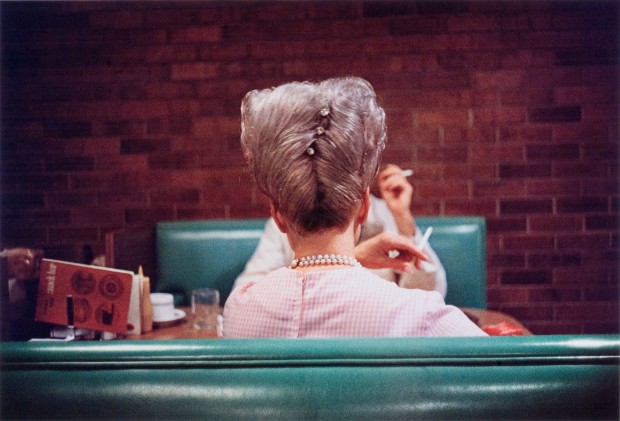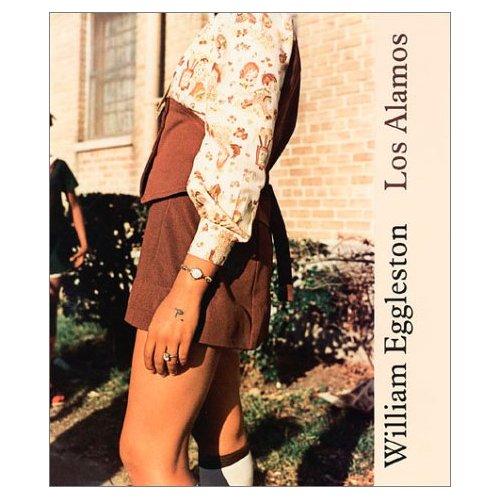An iconographic and text archive related to communication, technology and art.
☛ William Eggleston: Untitled, n.d., from the Los Alamos portofolio, 1965-1974 (first published by Scalo, Zurich, 2003), dye transfer print, 12 x 17 ¾ inches (30.5 x 45.1 cm.) © Eggleston Artistic Trust. The digital copy shown above was found over at the Newcity Art website.
Originally shot on negative film between 1965 and 1974 during a road trip in the American South and West with his friend Walter Hopps (who was also an art critic, an American museum director and a curator; he died in 2005):
The body of work takes its title from the Los Alamos laboratory for the development of atomic weapons, which Hopps is said to have pointed out to Eggleston while driving through New Mexico. Eggleston was intrigued by the site, and so he dubbed the series The Los Alamos Project. In its original concept, the Los Alamos images would be shown only as a group, with no commentary, titles, or representational hierarchy, essentially imitating for the viewer the artist’s own visual experience of the world. “I had this notion of what I called a democratic way of looking around, that nothing was more or less important,” Eggleston has remarked. Most of the images are geographically nondescript, and thus remain strangely timeless, like series of moments continually happening in the present. (read more)
The photographs were then put aside by the artist. The color photographs from the Los Alamos Project were rediscovered and exhibited for the first time a few years ago, in 2003 (from March 15 to June 9), by the Ludwig Museum in Germany. The exhibition was curated by Thomas Weski who also helped putting together, along with Walter Hopps, a fully illustrated catalog. This catalog was published by the Swiss art book publisher Scalo (which went bankrupt in 2006).
The exhibition traveled for the first time in the United-States in 2004, when in went on view at the San Francisco Museum of Modern Art (SFMOMA) (from August 21, 2004, through January 2, 2005):
William Eggleston is known for his pioneering work in color photography, which he helped establish as a serious artistic medium. Using a color intense, dye-transfer printing process and working within the seemingly artless snapshot style, Eggleston photographed everyday life, adhering to a philosophy of the “democratic camera” that ignored representational hierarchies. The images in the Los Alamos series were taken between 1965 and 1974 during Eggleston’s travels in the American South and West. The 88 prints in the exhibition include the first image in this body, taken in his hometown of Memphis, as well as pictures of the Mississippi Delta, New Orleans, Las Vegas, Los Angeles, and more. (SFMOMA)
On October 13, 2008, a lot of 75 dye-transfer prints (each signed by Eggleston) was sold by Christie’s for 1,022,500$ (US). Here’s the lot notes, which are taken from the portofolio introduction written by Walter Hopps:
While driving through New Mexico in 1973, William Eggleston stopped at Los Alamos, the forested site of the atomic bomb’s clandestine development. He chose Los Alamos as the title for a sprawling body of work then nearing completion: approximately twenty-two hundred images photographed between 1965 and 1974. This title cloaks with some irony Eggleston’s ostensible subjects, yet acknowledges his belief in the aesthetic consequences of his private quest.
The photographs that make up this selection from Los Alamos begin at the beginning, with the first color photograph Eggleston made, of a grocery clerk pushing a shopping cart; include the center of his world- Memphis and the Mississippi Delta; trace his travels west from New Orleans to Las Vegas and southern California; and end on the Santa Monica Pier.
That day in New Mexico, passing through the piñon woods of the Jemez Mountains, past the guard gates of the National Laboratory, Eggleston turned with a small smile and said, ‘You know, I’d like to have a secret lab like that myself.’ It seems clear from the investigations collected in Los Alamos that he already had found the key to his proper place of research. (Christie’s, Lot 144)
The less fortunate can still find copies of the original Scalo edition on Amazon, eBay and at AbeBooks. As of today, prices start at 120$ (US).
- By Philippe Theophanidis
- on
- ― Published in Art, Photography
- Tagged: America, Eggleston, exhibition, portofolio, woman


